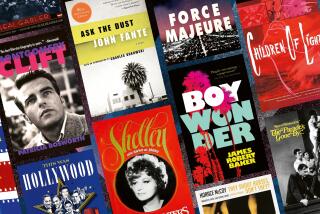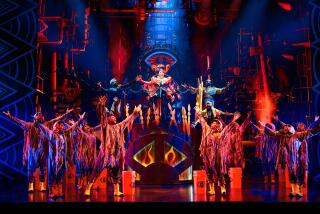âThe Real Wizard of Ozâ by Rebecca Loncraine
The Real Wizard of Oz
The Life and Times of L. Frank Baum
Rebecca Loncraine
Gotham Books: 416 pp., $28
In contrast to the rambling text that follows, the title of this biography couldnât be more cogent. L. Frank Baum, inventor of the magical Land of Oz, does indeed strikingly resemble the fraudulent but fundamentally good-hearted Wizard who put green-colored spectacles on Dorothy, her friends and the residents of the Emerald City. Not that Baum ever cheated anyone outright, but this son of the Gilded Age was intimately familiar with the tricks and showmanship that built modern commerce, as well as the yearning for a freer, more fantastic realm beyond the harsh realities of life on the Great Plains or in Americaâs rapidly industrializing cities. Think of him as actor Frank Morgan in the movie -- not so much when playing the Wizard, but as the cheerful charlatan Professor Marvel -- and you wonât be far wrong.
Baum was 43 years old when he completed his most famous story in 1899. He promptly signed and dated the manuscript, under the words âWith This Pencil I wrote the MS of The Emerald City.â (It was retitled âThe Wonderful Wizard of Ozâ just before publication in 1900.) Then he stuck his worn-down pencil to the paper. âThis pencil would write nothing more,â proclaims Loncraine. Itâs a typically portentous statement, but on this occasion (aptly chosen for the biographyâs opening scene) itâs appropriate; the author captures her subjectâs sense of a defining moment. He had waited a long time for it.
Born in an upstate New York village, Baum grew up in an unstable atmosphere roiled by his fatherâs fluctuating business fortunes. When Frank was 5, Benjamin Baum left a failing barrel factory (and an unpaid loan on it) and moved his family to the bustling city of Syracuse. Heâd become president of a bank and was speculating in the stock market by the time Frank was 12; the Baums were now living in a three-story mansion. A two-year stint at a military academy proved miserable for Frank, whose preferred reading was the Brothers Grimm and Hans Christian Andersen. In any case, his education was over by the time he was 17, when his fatherâs bank failed.
In the 26 years between leaving school and writing âThe Emerald City,â Baum managed a touring theater company, playing the leads and fashioning some of the scripts. He worked in a dry goods store, sold axle oil and opened a luxury goods emporium in the Dakota Territory, confident that prairie homesteaders pined for finger bowls and silver call bells. When Baumâs Bazaar went bust, he bought a newspaper, startling readers with editorials supporting womenâs suffrage and avowing his belief in reincarnation.
When the newspaper went bust too, he relocated to Chicago, working as a department store buyer and a traveling china salesman, hawking fireworks on the side. He was a man on the make, willing to try anything to get ahead. Wife Maud stuck with him through it all, producing four sons and developing a reputation for having a short temper. (Who wouldnât, under those circumstances?)
British journalist Loncraine paints a touching portrait of the coupleâs mutual devotion, but she has a more uncertain grasp on the distinctively American nature of Baumâs zigzagging trajectory, which she writes about with a maddening mix of shrewdness and overstatement. Sheâs capable of perceptively spotlighting things that obviously lingered in Baumâs creative memory: the tornado reported in his Dakota newspaper that lifted a schoolhouse 300 feet in the air; the blend of magic and fakery in the gleaming White City of the Chicago Worldâs Fair.
Sheâs also prone to bizarre generalizations: He didnât like discipline because he was left-handed; the marbled endpapers of the books he read as a boy âmirrored the insides of the rooms of the time, creating a sense of continuum between the outside world and the world of stories.â The claim that Baum âwas almost unable to distinguish reality from storyâ is reiterated with very scant supporting evidence.
On the contrary, as the author demonstrates in more astute passages, Baumâs erratic career gave him a thorough acquaintance with lifeâs hard knocks, as well as with the money that might be made trafficking in illusions for customers half-willing to be fooled. In 1897, just as Baum was discovering his vocation by turning the stories he told his sons into a collection published as âFather Goose, His Book,â he was also immersed in the launch of a magazine devoted to the newfangled window displays that lured passersby into department stores with an array of theatrical effects.
Everything Baum had experienced and imagined went into the hopper for âThe Wonderful Wizard of Oz,â and its bestselling success attested to the profound chord he struck by grounding a delightful fantasy in a frank portrait of the dour environment Dorothy was escaping (the book is far less sentimental about âhomeâ than the movie) and a blunt acknowledgment that humbug was everywhere.
Prosperity and fame didnât really change Baum; he zestfully spent every nickel and was always ready to throw himself into new ventures. He published adult fiction and other childrenâs books, but always ended up writing more âOzâ tales because nothing else sold as well. He was fascinated by the fledgling art of motion pictures and toured the country in 1908 with a show that employed colorized film and trick photography to depict episodes from the first three âOzâ books, with the accompaniment of a live orchestra. This visionary but ruinously expensive production, coupled with his lavish lifestyle, ultimately led to Baumâs bankruptcy in 1911.
By then he was living in Hollywood, and he salvaged his finances by cranking out an âOzâ title each year from 1913 on. When he took another disastrous go at the movie business in 1914, he lost investorsâ money rather than his own, and the stress undoubtedly contributed to the onslaught of ailments that ended with Baumâs death in 1919. Still, the life Loncraine chronicles with intermittent acuity seems to have been a happy one, nourished by chasing dreams rather than settling for the everyday.
Smith is the author of âReal Life Drama: The Group Theatre and America, 1931-1940.â
More to Read
The biggest entertainment stories
Get our big stories about Hollywood, film, television, music, arts, culture and more right in your inbox as soon as they publish.
You may occasionally receive promotional content from the Los Angeles Times.










